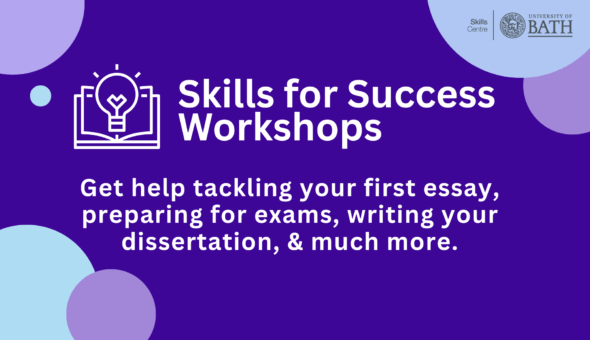Generative Artificial Intelligence (GenAI) presents both opportunities and challenges for students in higher education. GenAI tools are software applications that use artificial intelligence to generate content, such as text, images, or music, based on input data. Examples include large language models, such as GPT-4, image generators, and music composition tools.
This guidance parallels guidance issued for staff. Although this guidance is informed by existing legal frameworks, it does not in itself constitute legal advice, and the situation is constantly evolving.
Ethical and legal issues
What are some general ethical concerns as regards GenAI?
While many students and staff at the University of Bath are excited about the opportunities GenAI presents, there are legitimate concerns. These include, but are not limited to, issues around:
- Sustainability: GenAI uses an enormous amount of power.
- Privacy: Concerns about data being misappropriated.
- Data: AI models are trained on vast amounts of data, and many companies did not seek permission to scrape this data from the copyright holder.
- Equality: GenAI models reflect their training data, and so can produce answers which suppress minority views and reinforce existing inequalities.
- Academic Integrity: The expectation that students should complete assessments using their own knowledge and skills.
It is important to be aware of and sensitive to these concerns.
What are some legal concerns as regards GenAI?
The main issues to consider when using GenAI are those around data protection and copyright laws. When considering inputting material into GenAI, ask yourself:
'Do I own the copyright to this material?'
Copyright belongs to the author or creator of original work, whether in writing or an audio-visual medium, unless or until those intellectual property rights are assigned to someone else. Accordingly, in most cases, you own the copyright to your notes and assessments, and it would be an infringement of your copyright if someone were to copy, share, broadcast or adapt your work without your explicit permission, all of which arguably occur when inputting your work into a GenAI tool.
Explicit permission in this context means that you must actively 'opt in' rather than 'opting out'. This means your lecturer or tutor should transparently inform you of their intentions regarding your work and ask you to indicate that you provide your permission.
How does data protection legislation, such as General Data Protection Regulation (GDPR), intersect with GenAI?
It is always important to be aware of the provisions of GDPR. Even where you have given permission for your work to be inputted into an AI tool, you are still entitled to certain legal protections:
- For your work not to be personally identifiable. This involves more than simply redacting your name. For example, details within the assignment itself may give clues to your identity. You should also be aware that the metadata of files often indicates the author. It may be possible to remove this.
- You have a right for your data not to be held indefinitely. When your data is no longer required it should be securely deleted.
Please note that if you are privy to any confidential or commercially sensitive data this should never be shared with AI.
Guidance on using GenAI when inputting your own prompts/data
Is there a particular GenAI tool that it would be better to use than another?
Yes. Microsoft Copilot chat, when accessed through your university login, does not collect chat logs or data or train the wider model. We therefore advise using this tool in preference to any other when handling your coursework or research data.
Is it legal and ethical to use GenAI tools to create academic work?
The legality and ethics of using GenAI depend on your course policies and the specific assignment requirements. Always:
- Check your course handbook and assignment briefs for specific guidance on AI use.
- When in doubt, ask your lecturer or tutors for clarification.
- Be transparent about your use of GenAI.
- Draw on material you own the copyright to or is open source.
- Verify any information or content generated by AI tools.
Be aware that anything you create using GenAI may be used to train the AI tool and will thus, in some sense, be made public.
Always review and verify the AI-generated content before using it in your academic work.
Can I use GenAI to create images and are there any legal restrictions on how I use them?
There are three issues to consider when using GenAI to create images:
- Who owns the copyright to the image.
- Whether you are producing a derivative work and thereby infringing someone's existing copyright.
- Whether you are infringing a trademark.
Although legal frameworks around the world are still determining the legal status of images created using GenAI, all agree that the AI tool itself cannot own the copyright as this can only belong to a human. This leaves three options for ownership of copyright:
- The user of the AI tool owns the copyright: however, most legal frameworks agree that for a human to own the copyright they must have had substantial input into that image, though it is difficult to define what is meant by 'substantial'.
- The developers of the AI tool own the copyright: whether they assert their rights to copyright can be found in their terms of service.
- The image is public domain: the developers do not assert their rights and there has been insufficient human input to establish copyright.
The most prudent approach is to assume you do not have the copyright and therefore seek relevant permissions and reference the image using the guidance on the library website.
Fair Dealing allows limited use of copyrighted material without permission for educational purposes. This amount should be 'reasonable' and not harm the market for the original work.
- It is best to avoid generating images that might be regarded as derivative works. This would include prompting GenAI, either explicitly or implicitly, to generate an image that closely resembles someone else's intellectual property. For example, the University of Bath's logo with its distinctive Gorgon's head.
- It is also best to avoid explicitly or implicitly prompting AI to produce an image that infringes a registered trademark. A trademark is any symbol, word, phrase, design, or combination of these that identifies and distinguishes the source of goods or services. For example, the Paralympic Games' 'three agitos' symbol (three curved shapes in red, blue, and green) is a well-known trademark that represents inclusion and accessibility in sport.
Guidance on understanding your rights regarding your student data
Can my lecturer or tutor use AI detection tools on my submitted work?
When registering at the University, you give consent that your work will be put through the similarity checking software the University currently supports. This permission does not extend to the use of other tools, commonly marketed as 'AI detection tools'. In accordance with Ordinance Section 22.3(e) students do not give up their right to copyright by submitting their work for assessment. Assessed work is submitted by you to the tutor with the intention of it being evaluated and marked. Accordingly, any other use or processing of that assessed work is arguably a 'change of intent' and would require additional permission from you.
Can my lecturer or tutor use GenAI tools to assist in grading or giving feedback on my work?
University staff are expected to exercise their academic judgment when grading work and giving feedback. There may be a role for GenAI in editing or augmenting feedback, but both the initial and final judgment of grade and feedback should rest with academic staff when handling summative work, regardless of whether you have given permission for your work to be inputted into AI.
For formative work, so long as there is transparency with you and your permission has been given, then using AI to grade and give feedback is acceptable.
Might my lecturer or tutor ask for my permission to input my work into AI?
Yes, your lecturer or tutor might request your permission to input your work into an AI tool. If they do, they should use a specific form that clearly outlines what they intend to do with your work and how it will be protected.
Remember that giving permission is entirely voluntary, you are under no obligation to agree.
I want to use GenAI in my research project, what's the process for this?
Student research projects involving AI should be processed via the Ethics@Bath online review system, which has been in place since September 2023. Each department has a panel or pool of reviewers to consider proposals where research is being conducted that involves 'human participation, their data or tissue'.
Consult with your research supervisor early in the process to ensure you're following appropriate protocols for your specific project.
For further information or support in using GenAI tools effectively in your studies, please visit the Skills Centre GenAI resources on UniHub or speak with your lecturer of tutor.
Respond




